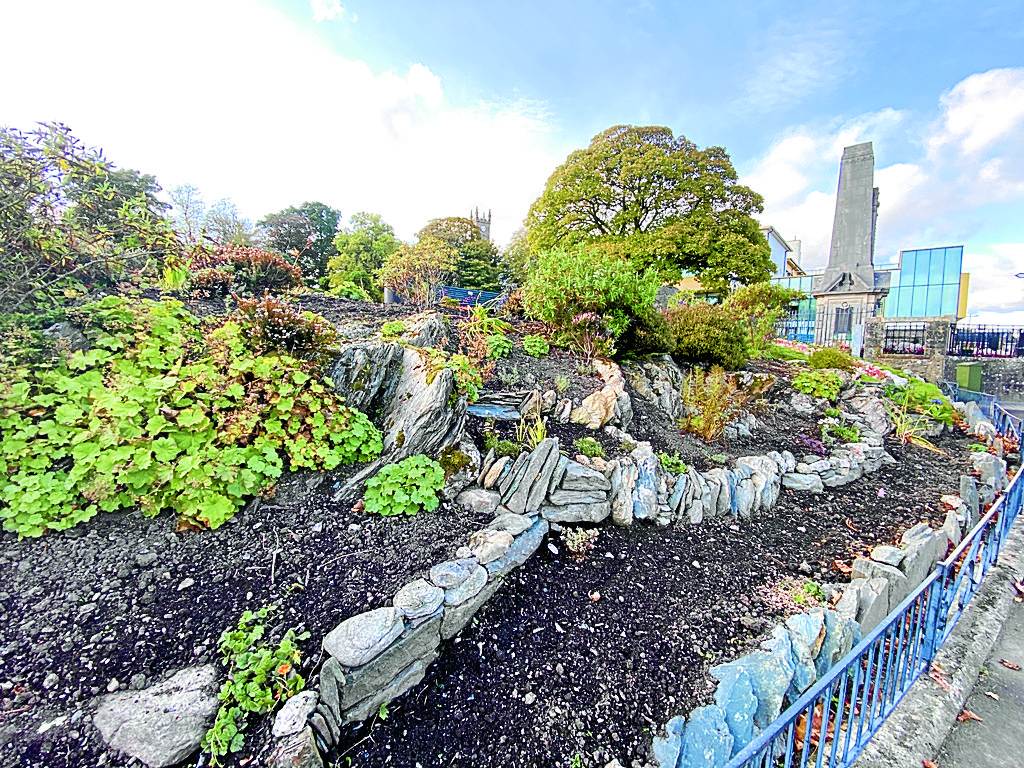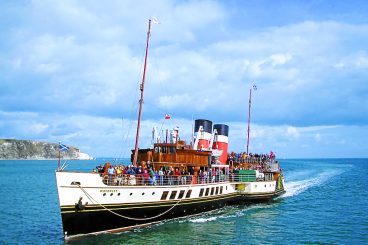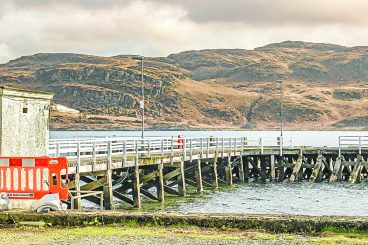TWO local council workers, known locally as Peter and David, recently embarked on a transformative project to rejuvenate the town’s historic Highland Mary statue and the rockery along Castle Gardens.
The duo took it upon themselves to cut back years of overgrowth that had crept up around the statue and created a rockery in the flower beds next to the Cenotaph. Though they tackled the project during regular working hours, their efforts went beyond routine maintenance.
What began as a straightforward task quickly turned into an archaeological-style uncovering of forgotten features. As Peter and David cleared layers of vegetation, they unearthed a variety of historic landscaping elements that had been hidden for decades.
Pathways, borders, and even the original cast iron railings were uncovered, offering a glimpse into how Castle Hill’s appearance would have charmed visitors in years gone by. The statue of Highland Mary, already a beloved landmark, is now surrounded by these rediscovered elements, giving the site a refreshed, authentic charm that recalls its Victorian origins.
However, Peter and David went even further with their operation by posting on social media an appeal for the donation of plants for the Castle Gardens and surrounding area and set up a Go Fund Me page online which raised £350.
Not only did this give the local public a chance to involve themselves in this restoration project but also gave Peter and David the opportunity to manage a budget, which they then used to buy flora and fauna.
Locals passing noticed their work, sparking conversations about Castle Hill’s history and attracting renewed community interest in its preservation. The topic of the restoration was raised a number of times at recent Dunoon Community Council meetings where remarks made at the impact the pair’s work was having.
Thanks to Peter and David’s initiative, the Highland Mary statue now stands more proudly than ever, visible against the restored backdrop of its historic surroundings. Peter said: “ We want to be proud of the town we live in and its important to get the local community involved so they feel part of something like this. In our everyday work with the local authority we go out and try to raise the profile of the town. This project has been like tipping our cap to the past.”
Peter added: “We want to thank Dunoon Primary School Nursery who bought various plants, Walkers Garden Centre for compost and plants, members of the public for all their donations and especially to the person who supplied us with doughnuts.”
The statue of Highland Mary has graced Dunoon’s Castle Hill since 1896, though it sparked debate long before its unveiling. The statue commemorates Mary Campbell, born in Dunoon and remembered for her relationship with poet Robert Burns before her untimely death. Standing over ten feet tall, it was funded by Burns societies worldwide as part of the centenary of the poet’s death. However, the idea stirred controversy, with newspaper debates questioning Mary’s worthiness of such a tribute.
Mary Campbell was born in 1763 at Auchamore Farm, Dunoon, later moving to Campbeltown and then Greenock. Her romance with Burns blossomed while she worked as a dairymaid in Ayrshire. The couple “handfasted” in 1786, a traditional Scottish betrothal, exchanging Bibles and performing a ritual in a local stream. However, she died soon after, aged 23, likely from typhus.
The campaign for the statue began with the Glasgow Cowal Society in 1886, who envisioned a memorial on Auchamore Farm. After discussion, Castle Hill was chosen, and fundraising events ensued, including international contributions from Burns clubs. Nonetheless, some criticised the statue, arguing it misrepresented Mary’s simple life and overshadowed her burial place in Greenock.
Despite opposition, renowned sculptor David Watson Stevenson created the bronze figure of Mary holding a Bible and gazing towards Ayrshire. The statue was unveiled on 1 August 1896 before thousands of spectators. The ceremony featured speeches extolling Mary’s legacy and a grand evening garden party with lanterns, music, and electric lights to celebrate the beloved statue’s place in Dunoon’s landscape.
Dunoon Castle has an equally fascinating history, one of Argyll’s oldest landmarks, dating back to the 13th century. While its walls have vanished, a centuries-old tradition persists: an annual token tribute to the monarch. In 1473, King James III granted Colin Campbell, the 1st Earl of Argyll, the keepership of Dunoon Castle. The Earl used the castle and its lands for a symbolic ‘blench’ rent: a single red rose, due only ‘if asked.’
Historically, Scotland’s monarchs relied on clan chiefs like Earl Colin to enforce order and collect rents, which were sometimes as modest as a silver shilling or a pair of gloves. Though rarely demanded, the red rose tradition continued, even during Queen Mary’s visit in 1563. Most recently, in 1958, Queen Elizabeth II received her red rose from Captain Michael Campbell, Keeper of Dunstaffnage Castle.
Should King Charles III visit Dunoon, the Duke of Argyll will uphold this unique custom.
* Information about Castle Hill supplied by Bob Reid.












